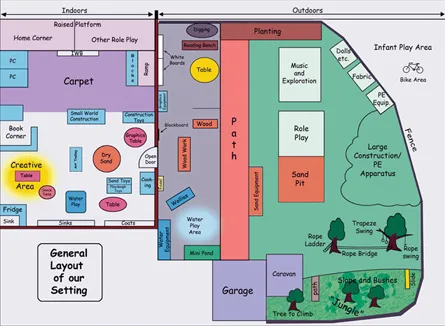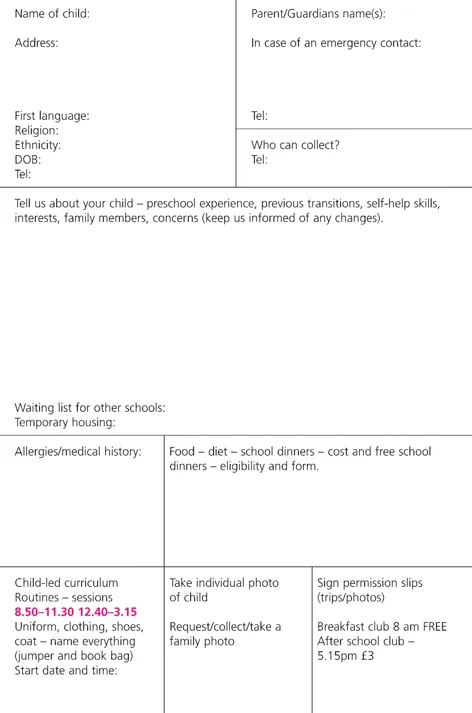![]()
1 September
This chapter is structured differently to the others to reflect the unique nature of this month. The Organisation section is divided into two parts, with the Environment section in between. This is to emphasise how vital it is to do preparation work – both in terms of getting to know the families and setting up the environment – before the children start school. The unique timetable for September is explained and, in terms of setting up the class and garden, the general principles are described. I also explain home visits, our induction programme and how our daily routine is organised. In the Diary section, I describe the earliest work to start the development of self-discipline and look briefly at the introduction of woodwork.
| September: To Do List • Settle Year 1 children into their new class. • Arrange classroom and garden. • Label resources – with words and pictures. • Select children to form groups for staggered intake. • Carry out home visits. • Amend/add to resources according to information gathered. • Collect information from previous settings. • Pass on information to school office. • Flag up Special Needs issues with the SENCO. • Set up a folder for each child. • Induct new staff into planning/record-keeping systems. • Stagger intake over two weeks. • Concentrate on establishing ground rules and routines. • Reassess and evaluate class and garden organisation. • Complete and collate entry assessments. |
September timetable
September is a unique month for anyone working in Early Years; a period when preparation is carried out that will have lasting effects. At De Bohun, we delay our start date by two or three days (as shown by the yellow highlights below) so the whole team can work to implement changes and set up the class and garden in the best possible way. Many head teachers need convincing of the value gained by this. It is vital to explain in detail what the time will be used for and how it will affect the whole year. If your setting does not run on a school year, I would still argue for these ‘closure days’ at some point in the year. Thus, by the end of September, the class and garden are set up and all the children are attending for half-day sessions.
Figure 1.1 September timetable
The work that is done in the class and garden during this period will depend on the individual situation of the setting. Organisation is key – decide on priorities, allocate tasks and celebrate the results. There may be no budget at all, but that should not prevent change. For example, it costs nothing to dig over an area of hard ground to make a digging pit, to clear out and de-clutter the storage areas, to design and discuss a new planning sheet, to set up a folder for each child or to reorganise the creative area indoors. As you read this book you will come across ideas that will require thought, adaptation to your setting and time to put them into practice. I have an ongoing wish list for my class, and as soon as I get to the end of the list, there is another list below. You may find it necessary to make different lists: one for long-term vision (e. g. including some aspects of building work or staffing), a second for ideas that have a financial cost (prioritised once any budget is known) and a third for ideas that just require time. The two or three preparation days in September can give your team a chance to make some of these changes. Involvement of all staff ensures a sense of ownership of any changes and responsibility for their maintenance during the year. New areas or ideas then have the best possible chance of success.
Setting up the environment
General principles
At De Bohun, we strive to ensure that the children feel safe and confident so that they can explore and play independently.
Ground rules are few, but are established from day 1 to ensure that every child feels able to explore freely. We are all respectful towards each other. This is taught by example and intervention whenever disrespect or unkindness is observed. Everyone must walk and talk indoors – if anyone wants to run and shout, they are directed to the garden. Everyone needs to take care of the class and garden and the things in it. During the first few weeks at school, the establishment of these expectations takes the majority of our time. We invest this time at the start of the year and see long-lasting benefits very quickly.
We constantly review the provision and layout of the class and garden. For example, if we observe that the carpet area is constantly overcrowded, we will try to make this area larger. The layout keeps certain activities away from others – e. g. quiet/noisy (such as book corner and role play area), wet/dry (such as water and computers) or messy/clean (such as painting and small world play).
Self-service units allow children to be independent.
We do not set resources out – the children select the resources and activities themselves (see Daily Routines below). The children should not need to approach an adult to ask for glue or to ask to go to the toilet. The interactions with adults should be far more meaningful and valuable (see Chapter 5). A good way to assess your own environment is to think about or monitor the reasons why children approach the adults. If it is to sort out disputes, then this is an area that needs focus. If it is to request resources, then this needs attention. If it is to ask permission to do something, then maybe the boundaries and agreements need restating. As new issues arise we adapt the provision or spend time working on a particular aspect of behaviour.
We have removed everything from the class and garden that is not for the children to access on a daily basis. Thus all adults’ belongings, special resources and resource boxes have been moved out of the classroom and stored elsewhere. Whenever possible, we replace inappropriate storage with units that allow the children to ‘self-serve’ resources. We are always on the lookout for furniture being discarded by other classes – often for use outdoors – a coating of gloss paint or a tarpaulin cover can mean the furniture gets a new lease of life. Storage units are labelled with photos and words to show what they should contain. In this way, the children can be independent when tidying up as well. Because the children get the resources out themselves, they also know where to put them when they have finished.
Figure 1.2 General layout of our setting
In the following chapters, the detailed provision in each area is described. However, the principle is constant – careful organisation and labelling that allows independent access to a wide variety of high-quality resources.
Many settings share an outdoor space between two or three classes. It is often a good idea to share indoor spaces too. For example, if you have two interconnecting classrooms, then have single provision over the two rooms. You can then have one large, but well resourced, role play area, one large creative area, and so on, rather than small areas in each room. The classes can still split for carpet sessions to keep these manageable and effective.
Home visits
We home-visit every child that joins our Reception class. It is a chance to start building a relationship with each family. It is vital that all adults involved with the child (at school and at home) feel part of a team that is working for the best interests of the child. At the home visit the family can talk in detail about their child, including any concerns and expectations. They can also explain the family background and culture. The ‘school’ has a chance to gather all this information from the family, to answer queries and concerns and to explain how the Reception class is organised (stressing the benefits of a child-led curriculum). Each visit lasts about 40 minutes and two adults go together – one to chat to a parent and one to play with the child. We take a selection of toys, books, paper, pencils, scissors and photos from school. Hopefully, these will engage the child and allow a glimpse into their interests as well as helping them to look forward to starting school. We also have lots of information to pass to parents, forms to complete and information to gather. We take school sweatshirts and book bags with us for parents to purchase. We fill in a form/checklist as we chat, to ensure nothing gets missed.
We do not send out the start dates and sessions before we have met the families. We have start dates in mind but these may be altered according to issues that arise at the home visit. For example, we usually start the youngest children first. However, if at a home visit we discover that one of the oldest children is very timid, then we may give them an earlier start date. We stress to all parents that they will need to stay with their child at school until they are settled and confident. For some, this will only be a few minutes; for others it may be six weeks.
This year we had several issues raised at home visits. One mother reported that her son is unable to clean himself after going to the toilet if he doesn’t have wet wipes. We suggested that she spend time in the following couple of weeks helping her son overcome this. Two mums said they were starting work so needed their children in full-time school as soon as possible. They also said they would be using breakfast club and after-school club. We stressed that we would do our best to settle the children as quickly as possible but that the interests of the child had to be paramount. We urged these parents to try to get a support network in place in case their child did not settle as quickly as they hoped. I was reminded of something I heard when visiting settings in Australia. A practitioner said, ‘We are not child-storage facilities’. This made me smile, but there is a serious message here. Schools in the UK are now expected to try to offer extended hours to allow parents to work if they wish. However, who benefits from this? Are we becoming ‘child-storage facilities’? What are the long-term effects on children who are in childcare from 8 am to 6 pm from the age of four months? When parents are pressurising us to take their children into school full-time, we need to be sure that it is the best thing for the child.
Figure 1.3 Home visit checklist
Family photos
When we send the home visit appointment, we request a family photo be available for us to take to school to be displayed in class. (We provide the frames.) If the family do not have a photo, we offer to take one with the school camera. They look great and a...





